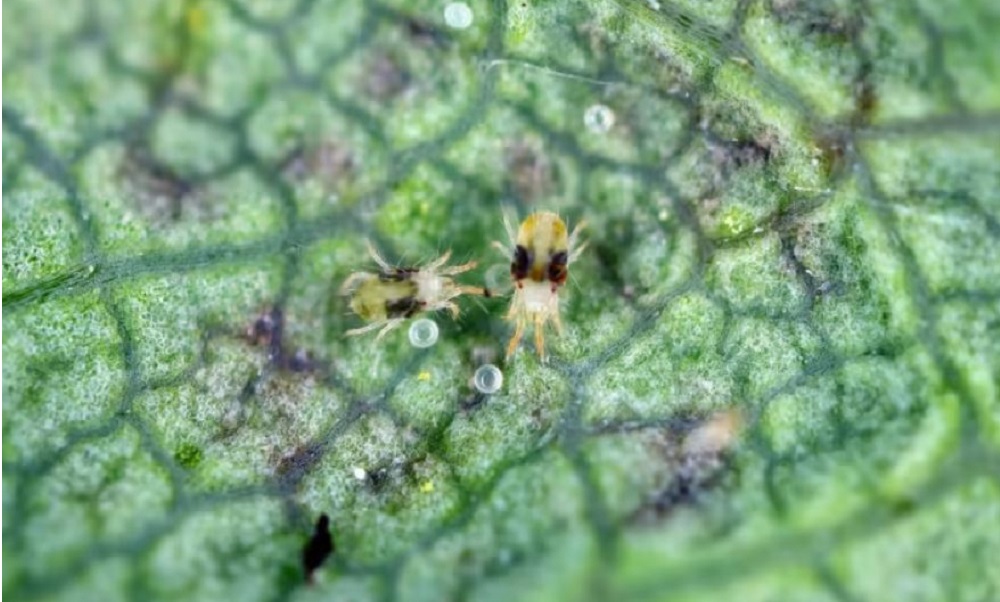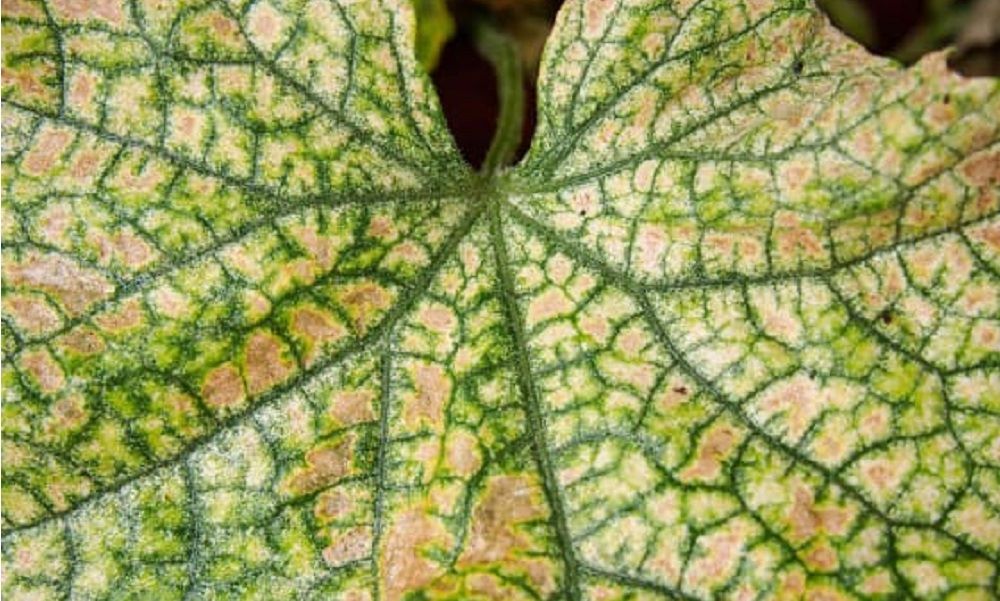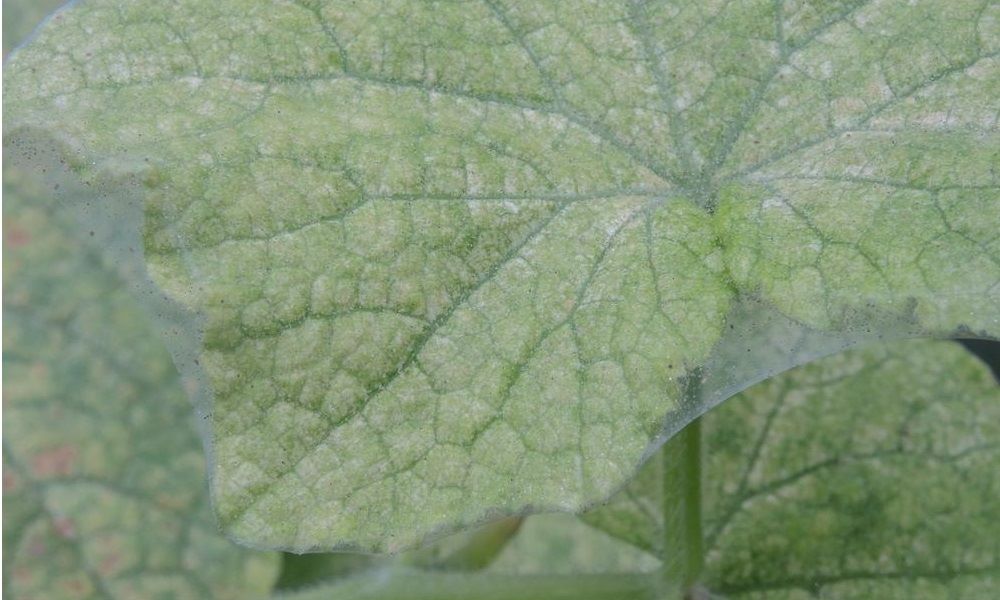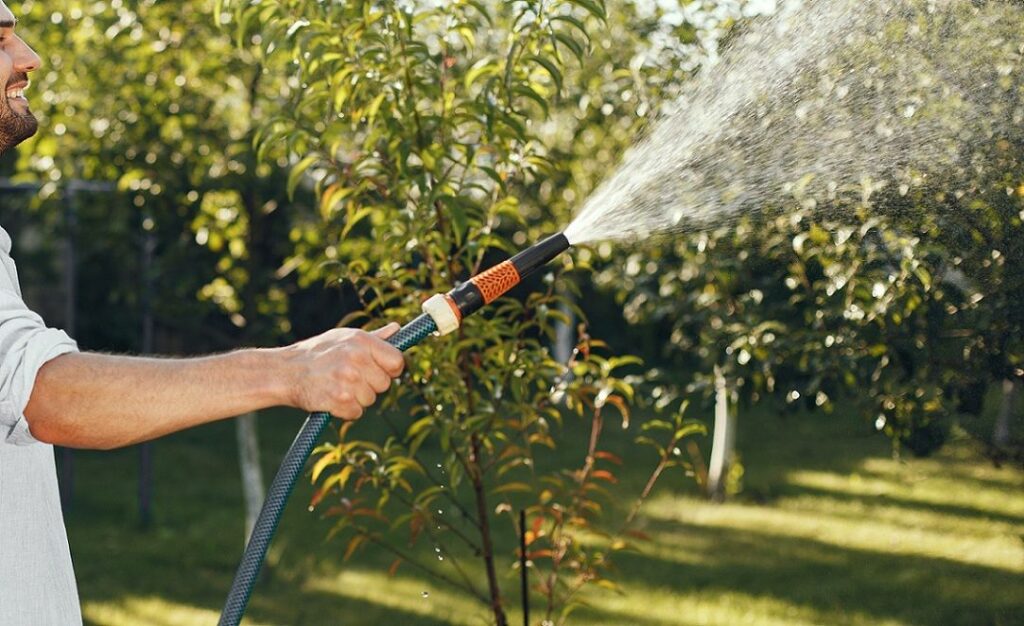Log in or create new account to save this product to your wishlist.
Spider Mites: Prevention, Control, and Treatment
Spider mites can be tricky to spot, but you'll notice the damage before you see them. Find out how to tackle the problem for good!
Latest articles
7 MIN 22 Jul How to keep your lawn in shape this summer 9 MIN 15 Jul Watering Your Garden: 10 Top Tips! 11 MIN 15 Jul Is Your Grass Type Right for your Garden? 11 MIN 10 Sep Create Your Low-Maintenance Garden – Tips and Ideas 11 MIN 08 Sep The Ultimate Guide to Choosing the Perfect Hedges for Your Garden 12 MIN 30 Aug The Top 20 Evergreen Climbers to Transform Your GardenYou might have noticed bright spots and little white webs on your plants — and the most likely cause are spider mites, which can quickly damage your beloved plants.
- Spider Mites 101
- How to identify spider mites
- When are spider mites most active?
- How to identify spider mite spots!
- Frequently infested plants
- Home remedies for fighting spider mites
- DIY remedy for spider mite infestations
- Fighting spider mites with natural enemies
- Targeted prevention after fighting spider mites
- FAQs
Spider mites are tiny little pests that hide underneath your plant’s leaves. So, there’s easy to miss if you’re not looking for them.
This article is about how to identify spider mites, then how to control their spread and treat plants damaged by these prolific little beasts.
Ready? Let’s go!
Spider Mites 101
Spider mites are tiny pests frequently found in the garden and on your houseplants. They’re around 0.2-0.5mm in size and hide on the underside of leaves, making them tricky to spot.
You’re more likely to notice a spider mite infestation by the failing condition of your plant’s leaves — most notably with the appearance of white or yellow spots.
The maw of the spider mite causes these spots as it sinks its teeth into the leaf to absorb sap. And in the case of a severe infestation, the leaves may even turn yellow and drop off.
And despite their short lifespan, spider mites multiply rapidly. The larvae develop into reproductive adults within six to fifteen days, making fighting a spider mite infestation a significant challenge. In the right conditions, a female spider mite lays up to one hundred eggs, which hatch within three days.
Lawn doctor Louis says:
In a warm greenhouse or sunny windowsill, spider mites can multiply all year round.
How to identify spider mites

Spider mites are often overlooked because they’re so tiny. So, you’re more likely to identify their presence by the little webs and the leaf damage as described earlier.
However, not all spider mites spin webs, which makes it even more challenging to identify them!
Look out for small leaf spots, occuring throughout the year on houseplants or greenhouses.
Under a microscope, spider mites are a pale green colour with black abdominal walls. They look more like tiny green ants than spiders and are almost invisible to the human eye.
When are spider mites most active?
Generally, spider mites are most active during the summer, from mid-May. However, they can remain active all year round in warm, dry greenhouses or your home, which is likely to be warm enough for them to thrive.
Spider mites enjoy heated rooms, so anywhere around the house can be welcoming for these microscopic critters!
How to identify spider mite spots!

Spider mites feed on the leaf cells of your plants, sucking the sugary sap your plant produces as a result of photosynthesis. Of course, your plant produces this sap to feed itself, so spider mites are a particularly damaging parasite.
The suction points become slightly silvery as the plant attempts to heal itself, eventually turning into light grey or bronze-coloured spots. While this is unsightly, it also increases your plants’ susceptibility to other pests and diseases — eventually, affected leaves just die and drop off.
Spider mites release poisonous saliva as they feed, which damages the plant while potentially transmitting harmful plant viruses.
Frequently infested plants
Typically, spider mites infest plants that are already weakened in some way. However, healthy plants are also susceptible.
The most frequently infested plants are:
Garden plants

While spider mites will infest most plants, they’re particularly keen on:
- Beans
- Cucumbers
- Roses
The fruit tree spider mite is a serious pest for — you’ve guessed it — fruit trees. The most commonly affected are:
- Apple trees
- Pear trees
- Peach trees
- Plum trees
But they also damage soft fruits, such as:
- Raspberries
- Strawberries
- Gooseberries
- Currants
Houseplants
Winter is a challenge for outdoor spider mites – they prefer warmer, drier indoor conditions. This makes your houseplants an easy winter target (although the problem can be year-round indoors).
Particular spider mite targets are:
- Rubber plants
- Orchids
- Azaleas
- Ivy
- Indoor palms
Remember to check underneath the leaves of these plants to identify infestations before they become problems.
Home remedies for fighting spider mites
Now to the core of the article: how to tackle spider mites. The earlier you identify the problem, the easier it is to deal with.
We’ve already established that spider mites enjoy warm, dry environments and are very unfond of change. Therefore, one approach is to move your plants to a colder room — maybe one you don’t heat as often as your living room.
However:
The magic word when fighting spider mites is water, which they don’t like.
So, spray your house plants profusely with a fine water spray. This will knock the little critters off the plants and reduce their population significantly. If that doesn’t work, try a more substantial stream of water — you might have to take your houseplants outside for this.
Fighting spider mites in the garden

Again, water is a great weapon.
So, spray your garden or balcony plants with a high-pressure water stream. Of course, ensure the water pressure isn’t so high that it will damage the leaves or knock off the flowers.
Carefully shower your plants, ensuring you drench the underside of the leaves. If you can, isolate your plants as you spray them; otherwise, you might spread the mites to other plants.
Do this in the early morning or early evening. This will stop the sun from scorching the wet leaves. Choose a cloudy day if you can.
However, ensure you don’t spray too late into the evening, as overnight moisture can encourage mould.
How to treat a strong spider mite infestation
Water alone might not be enough for a persistent infestation. So, you might need a spider mite spray, such as Miracle-Gro Bug Clear Ultra.
You’ll find many spider mite sprays in your garden centre or online. Just make sure you follow the instructions for safe use.
Spray the leaves evenly on all plant parts, especially underneath the leaves.
Again, use mite spray in the early morning or evening. You might need to apply the spray several times to eradicate a persistent infestation.
Alternatively, remove affected leaves if the plant is otherwise healthy and robust.
Lawn doctor Louis says:
Remove fallen leaves immediately, as spider mites hide underneath fallen leaves to hibernate. Dispose of infected leaves in your green waste bin; not in your home compost!
Once treated, increase the humidity

Spider mites hate humidity, so once you’ve attacked the problem in your houseplants, spray them regularly with a fine water mist, focusing on the underside of the leaves.
This also makes it easier to see the delicate webs spun by some spider mites, as the water will stick to the fine silk and make the plant inhospitable.
Remember: a fine water spray is most effective, especially in winter, for your houseplants. And it helps keep the leaves hydrated and green.
Spray your garden plants in the morning or early evening to wash away the mites — high pressure is good, but don’t damage your plants!
Lawn doctor Louis says:
Place a bowl of water on your radiator to keep the humidity high in your room. Or use a humidifier.
DIY remedy for spider mite infestations
A super DIY remedy for fighting spider mites is a spray of:
- Rapeseed oil
- Neem oil
- Nettle broth
- Juniper
- Tea
- Water
And while not all of those ingredients might be readily available, the oil droplets from rapeseed cling around the mite, suffocating them. So, any combination of the above with rapeseed oil and water will work.
Repeat several times to interrupt the reproductive cycle of the critters.
Fighting spider mites with natural enemies
Phytoseilus persimilis
One of the greenest ways to fight spider mites is with Phytoseilus persimilis — tiny creatures which are the spider mite’s natural predator. This approach is widely used as the better alternative to pesticides.
Apply these inside or outside — they respond well to the increased humidity required for tackling the spider mites.
Feltiella acarisuga
Alternatively, you might consider the Feltiella acarisuga — a predatory midge which will fight the spider mites on your behalf. These inconspicuous, nocturnal insects will destroy a spider mite colony in no time.
Now, this might sound a bit gross, but bear with me!
Once the Feltiella have mated, the females lay around one hundred eggs in the spider mite nests, which hatch after a few days. The Feltiella larvae then feed on the spider mite eggs, interrupting the reproductive cycle.
However, this approach won’t work as well in hot, dry conditions in the summer.
Atheta coriaria
This is a rove beetle, 3-4mm long, which is a predatory insect both in its adult and larval forms. It feeds on a range of invertebrates, including fungus gnats, spider mites, and thrips.
Targeted prevention after fighting spider mites
After applying one or more of these methods, your spider mite woes are over. So, now it’s time to prevent future generations of these little critters from returning.
Preventing spider mites in the greenhouse and garden

These tips will help keep your garden and greenhouse plants free of spider mites:
- Spray or shower your plants daily. Avoid doing this in direct sunlight or too close to nightfall. Pay particular attention to the underside of the leaves.
- Protect your plants from drought — add a mulch layer to maintain soil moisture and water regularly.
- Keep your greenhouse or cold frame well-ventilated.
- Clean beanstalks, perennial supports and trellises thoroughly after use. Pests often use these for overwintering hiding places.
- Ensure your plants get enough potassium when you fertilise. This increases resistance to diseases and pests while strengthening plant tissues.
- Focus on trunk care for your fruit trees in autumn. Remove loose pieces of bark with a hand hoe, and coat the area with a seal-n-heal treatment to protect it. This prevents frost cracks but also minimises overwintering pests.
Preventing spider mites indoors
The best ways to protect your houseplants from future spider mite infestations are:
- Counteract low humidity from autumn. Use water containers placed on radiators (not electric!) or invest in a humidifier. The closer you place the water containers to your plants, the better.
- Maintain plant health by removing dead or weakened branches, stems, or leaves.
- Spray your plants regularly during the winter — especially underneath the leaves.
FAQs
Apply plenty of moisture to your plants — spider mites hate water. Spray your plants regularly underneath the leaves. Add rapeseed or neem oil to suffocate the mites and isolate infested plants. Repeat every few days until the spider mites have gone.
The entire life cycle of the spider is just 18 days. So, killing spider mites takes at least this long to interrupt the reproductive cycle. Spray your plants with water, which spider mites hate — adding a few drops of neem oil or rapeseed oil will help suffocate the mites. Repeat until the infestation is defeated.
Spider mites thrive in dry and warm environments. So, attack the infestation with water and increased humidity. Add rapeseed or neem oil to a water sprayer to suffocate the mites.
Do you have questions?
I hope you’ve got all the info you need to attack your spider mite infestation. But if you have any questions, drop us an email or add a question to the comments below.
Or check out our comprehensive Help & Advice section. Or explore our articles relating to garden pests.
Thanks for reading!
Leave a comment
Your answer will be displayed on the site and the interested party will be notified by email.
Leave a comment
Have a question or want to share your experience? Leave us a comment.
Read more
The best tips and tricks for a lush green lawn
 7 MIN
13 Sep
Lavender Cuttings: a step-by-step guide
7 MIN
13 Sep
Lavender Cuttings: a step-by-step guide
 11 MIN
10 Sep
Create Your Low-Maintenance Garden – Tips and Ideas
11 MIN
10 Sep
Create Your Low-Maintenance Garden – Tips and Ideas
 Scarifying Kit
All products after scarifying | Quickly restores the lawn after scarifying | Outsmart weeds quickly with the use of this kit
From: € 39.99
Scarifying Kit
All products after scarifying | Quickly restores the lawn after scarifying | Outsmart weeds quickly with the use of this kit
From: € 39.99
 Spring Lawn Care Kit
MOOWY’s choice for the spring | Quick recovery of your lawn after winter | A strong lawn prevents weeds
From: € 25.99
Spring Lawn Care Kit
MOOWY’s choice for the spring | Quick recovery of your lawn after winter | A strong lawn prevents weeds
From: € 25.99
 Long Lasting Lawn Fertiliser
Effective for 90 days | See results in 14 days! | Suitable for all types of grass and soil
From: € 13.99
Long Lasting Lawn Fertiliser
Effective for 90 days | See results in 14 days! | Suitable for all types of grass and soil
From: € 13.99
Do you want a lawn calendar?
🌱 All important maintenance moments for your lawn during the year. Leave your email and we will send you the lawn calendar for free.
Enter your email
Receive the lawn calendar in the mail
Enjoy a green lawn all year round!











Comments (0)
There are no comments yet. Well then, what are you waiting for to
Be the first to write your comment!inaugurate this pretty page?
Do you have some comments?